NOVELCONCEPTS
Thermal Management Development
ABOUT

Novel Concepts develops, heat sinks, heat spreaders, Peltier coolers, cold plates, liquid cooled heat sinks, and associated thermal management technologies.
Since 1982, over 500 million heat sinks and thermal management devices have been manufactured by our clients, using our thermal designs and technologies.
With a core focus on computational fluid dynamics (CFD) integrated with proprietary variable optimization, Novel Concepts has uniquely solved some of the industry's most difficult thermal challenges.
Using high speed servers, Novel Concepts can quickly explore a large solution space, allowing for greater design flexibility, while improving the chances of finding those unique patentable solutions, necessary for today's competitive environment.
SERVICES
Since 1982, Novel Concepts has developed unmatched unique thermal management devices and systems, ranging from sub-millimeter thermal sensors, to hundreds of meters tall solar updraft tower power plants, including the devices below:
world's thinnest integrated fan heat sinks (patented)
world's thinnest active heat spreader (patented)
world's most thermally conductive plastic (patented)
world's thinnest forced convection heat sinks (patent pending)
very high efficiency (9%) solar updraft tower power plant SUTPP
lightweight air and liquid heat sinks, for military robotics
Peltier coolers (solid state thermoelectric coolers)
microfluidic cooling plates (microchannel heat sinks)
variable thermal conductivity materials (both PTC and NTC)
wearable thermal signaling devices
high efficiency (>90%) concentrated solar power receivers
lightweight compact heat exchangers for aerospace and avionics
cooling systems for unmanned vehicles (UAV, UGA, USV, UUV)
solid state temperature sensors for data acquisition
thin film and thick film heaters, on ceramic and glass
all-polyimide low thermal time constant heaters
transparent sapphire heaters
transient phase change heat sinks
CLIENTS
Novel Concepts provides its clients with all phases of development including, feasibility analysis, conceptual and engineering design, and system optimization. Below is a partial list of the many companies who have used our thermal management services.
3M
Agilent Technologies
Apple Computer
Applied Biosystems
Applied Materials
Atomic Aquatics
British Telecommunications
Cloud, LLC
Cutera
Cymer
Cytyc
Daylight Solutions
Delta Electronics Group
Device Semiconductor
Edisun Heliostats
Estari
Formation
IdeaLab
Intel
Juniper Networks
KDS Computers
Life Technologies
Meggitt Defense Systems
Monster Digital
Nidec Corporation
Philips
Red Digital Cinema Camera
Sanera Systems
Sanyo Denki Corporation
Syracuse Research
Tampa Microwave
Texas Instruments
HEATSINKS
Novel Concepts has been designing natural convection and forced convection heat sinks since 1982.
Primarily focused on high efficiency cooling of high-power density heat sources including, concentrated solar receivers, concentrated photovoltaics (solar cells), Peltier (thermoelectric) modules, high density LED arrays, power semiconductors, and microprocessors.
With forced-air convection heat sink volumetric efficiencies as high as 0.125 W/°C/cc (including fan), these compact heat sinks often replace active cooling systems.
Using proprietary variable optimization software, in conjunction with Computational Fluid Dynamics (CFD) analysis, heat sinks may be modeled and optimized using any related design constraints. This highly spatial, high resolution CFD analysis, allows Novel Concepts to design heat sinks (compact heat exchangers) with unmatched thermal performance and efficiency.
In addition to developing, patenting, and fabricating Intel's first forced convection cooled microprocessor heat sinks (over 500M manufactured), Novel Concepts designed and fabricated the first spherical liquid cooled heat sink for the $1M silicon sphere used in Cymer's EUV light source, used to produce 7nm, 5nm and 3nm semiconductors.
Novel Concepts has developed heat sinks for a wide variety of manufacturing methods, such as 3D printing, stamping, extruding, casting, powdered metallurgy, organically bonded fins, and brazed convoluted fins. Design materials include metals, plastics, ceramics, and composites.
OriginalIntelFanSink

Perspective view of a forced convection inlayed fan heat sink. Developed by Novel Concepts for Intel Corporation, for cooling their Boxed Processors, this is the original forced convection cooled series heat sink. This perimeter finned aluminum heat sink measures 46mm diameter by 14mm tall (17mm tall including inlayed fan), with a total thermal resistance of 0.44 °C/W. The volumetric thermal efficiency (including inlayed fan) is 0.080 W/°C/cc. Total weight 36 grams.
Developed and patented by Novel Concepts and manufactured by the tens of millions of units per year, this technology is the most prolifically manufactured forced convection heat sink in the world, by far.
US Patents 5,288,203 and 5,484,262.
HelicalHeatPipeHeatSinks
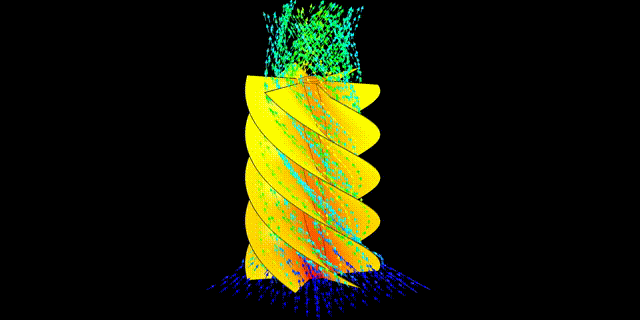
Perspective view of a free convection cooled helical fin heat sink, with a heat pipe core. Developed for high power LED lighting, this aluminum heat sink measures 100 mm diameter by 150 mm tall, with a total thermal resistance of 0.855 °C/W (@ 50°C ΔT). The volumetric thermal efficiency equals 0.0010 W/°C/cc. Total weight 168 grams.
LiquidPinFinHeatSinks
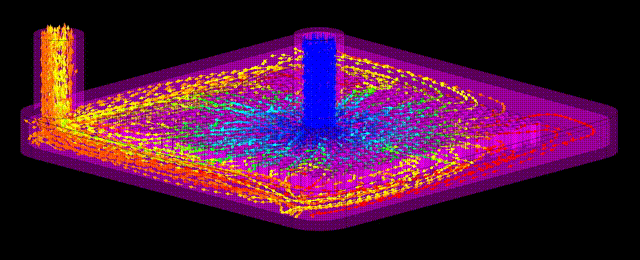
Perspective translucent view of a copper liquid cooled pin fin heat sink. Developed for high power density semiconductors this copper liquid cooled pin fin heat sink measures 55mm by 55mm by 5mm tall (excluding tube connectors), and has a total thermal resistance of 0.030 °C/W. Pressure drop is 728 Pa (0.10 psi) at 0.5 lpm (0.13 gpm). The volumetric thermal efficiency is 2.185 W/°C/cc. Total mass 83 grams.
PinFinHeatSinks
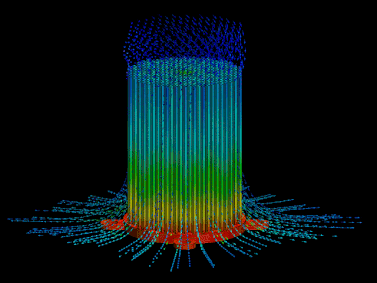
Perspective view of a forced convection pin fin heat sink. Developed for cooling high power LEDs used in LCD projection equipment, this aluminum heat sink measures 38mm diameter by 50mm tall (93mm tall including fan and plenum), with a total thermal resistance of 0.37 °C/W. The volumetric thermal efficiency (including fan and plenum) equals 0.026 W/°C/cc. Total weight 104 grams.
FreeConvectionHeatSinks
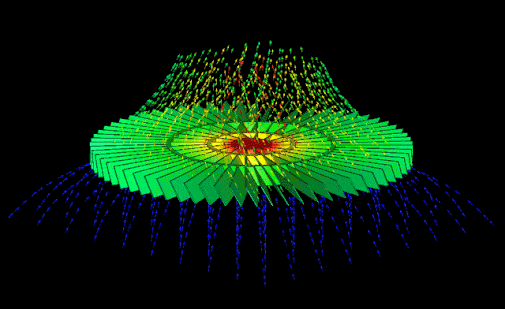
Perspective view of a low profile aluminum free convection heat sink. Developed for cooling LED lighting, this lightweight aluminum heat sink measures 160mm diameter by 10mm tall, with a total thermal resistance of 1.62 °C/W. The volumetric thermal efficiency equals 0.0031 W/°C/cc. Total weight 79 grams.
FinlessLiquidHeatSinks
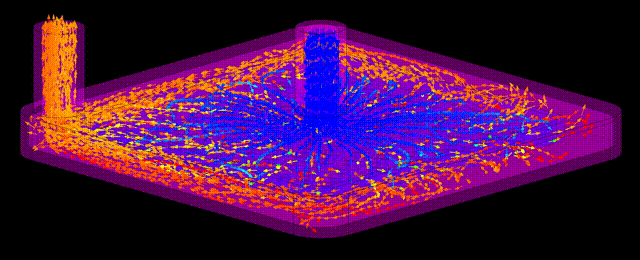
Perspective translucent view of a finless copper liquid cooled heat sink. A series of parallel high velocity fluid jets are directed towards the heated region, through a manifold. Developed for high power density Peltier modules, this finless copper liquid cooled heat sink measures 55mm by 55mm by 5mm tall (excluding tube connectors), and has a total thermal resistance of 0.0353 °C/W. Pressure drop is 18,263 Pa (2.65 psi) at 1.0 lpm (0.26 gpm). The volumetric thermal efficiency equals 1.875 W/°C/cc. Total weight 88 grams.
NaturalConvectionHeatSinks
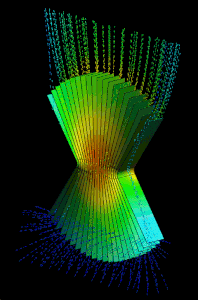
Perspective view of a convergent-divergent aluminum natural convection heat sink. Developed for cooling solid state thermoelectric Peltier modules for compact refrigerators, this aluminum heat sink measures 450mm by 600mm by 75mm, with a total thermal resistance of 0.225 °C/W. The volumetric thermal efficiency equals 0.00022 W/°C/cc. Total weight 1,953 grams.
VaporChamberHeatSinks
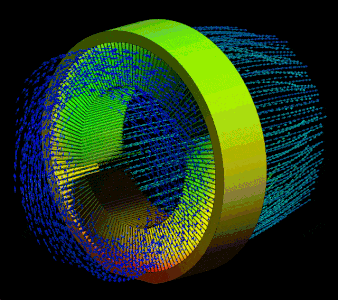
Perspective view of a forced convection annular heat sink, with annular vapor chamber base. Developed for cooling high power microprocessors, this aluminum heat sink measures 64mm diameter by 15mm tall (63mm tall including fan and plenum), with a total thermal resistance of 0.222 °C/W. This heat sink was optimized for 29.2 CFM at 0.67 inches of water. The volumetric thermal efficiency (including fan and plenum) equals 0.022 W/°C/cc. Total weight 140 grams.
MicrochannelLiquidHeatSinks
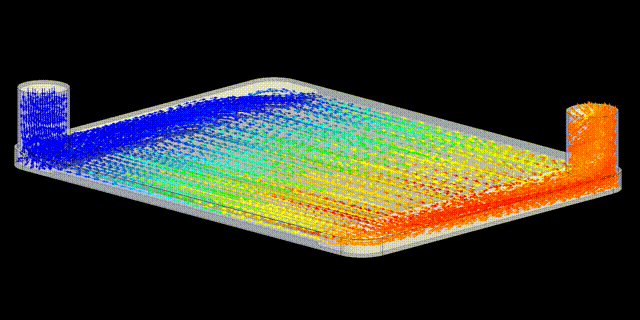
Perspective translucent view of a microchannel copper liquid cooled heat sink. This heat sink features an inverted symmetry entrance and exit manifold, for uniform fluid flow. Developed for a high power semiconductors, this copper liquid cooled heat sink measures 82mm by 62mm by 3mm tall (excluding connectors), with a total thermal resistance of 0.0092 °C/W. Pressure drop is 18,990 Pa (2.75 psi) at 1.5 lpm (0.40 gpm). The volumetric thermal efficiency equals 9.469 W/°C/cc. Total weight 102 grams.
ForcedConvectionHeatSinks
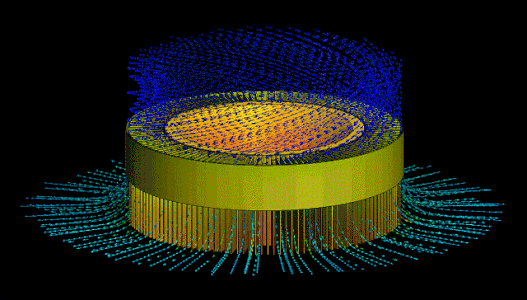
Perspective view of a low profile aluminum forced convection radial heat sink. Developed for cooling power semiconductors, this lightweight aluminum heat sink measures 60mm diameter by 20mm tall (68mm tall including fan and plenum), with a total thermal resistance of 0.258 °C/W. This heat sink was optimized for 19.9 CFM at 0.82 inches of water. The volumetric thermal efficiency (including fan and plenum) equals 0.020 W/°C/cc. Total weight 204 grams.
FoldedFinLiquidHeatSinks
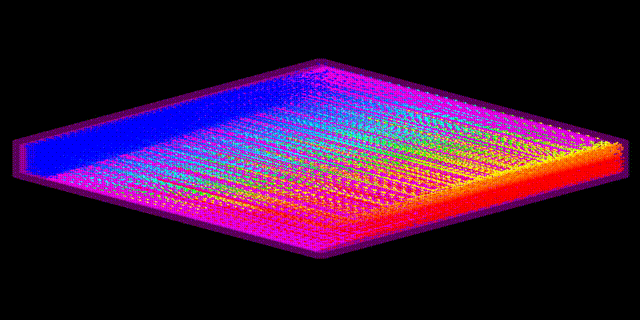
Perspective translucent view of a folded fin copper liquid cooled heat sink. This heat sink has a folded (convoluted) fin core, with an inverted symmetry entrance and exit manifold, for uniform fluid flow. Developed for a high power density Peltier array, this copper liquid cooled heat sink measures 120mm by 120mm by 10mm tall, with a total thermal resistance of 0.0062 °C/W. Pressure drop is 4,031 Pa (0.58 psi) at 1.5 lpm (0.40 gpm). The volumetric thermal efficiency equals 1.126 W/°C/cc. Total weight 877 grams.
FanCooledHeatSinks
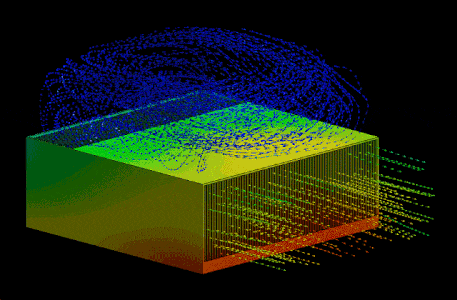
Perspective view of a low profile aluminum fan cooled heat sink. Developed for cooling solid state thermoelectric Peltier modules for compact refrigerators, this aluminum heat sink measures 60mm by 60mm by 22.5mm (75mm tall including fan and plenum), with a total thermal resistance of 0.179 °C/W. This heat sink was optimized for 13.2 CFM at 1.1 inches of water. The volumetric thermal efficiency (including fan and plenum) equals 0.021 W/°C/cc. Total weight 194 grams.
FreeConvectionHelicalHeatSinks
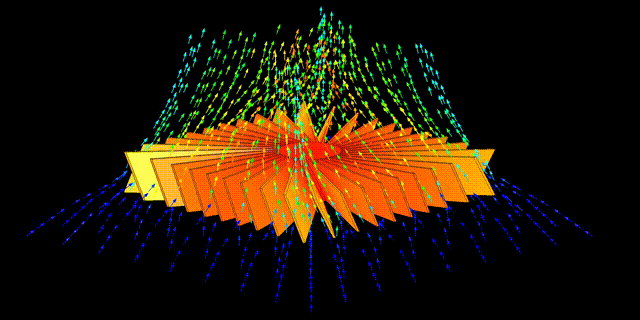
Perspective view of a free convection cooled helical fin heat sink. Developed for high power LED lighting, this aluminum heat sink measures 60mm by 60mm by 10mm tall, with a total thermal resistance of 2.47 °C/W (@ 50°C ΔT). The volumetric thermal efficiency equals 0.0113 W/°C/cc. Total weight 22 grams.
CastAluminumHeatSinks
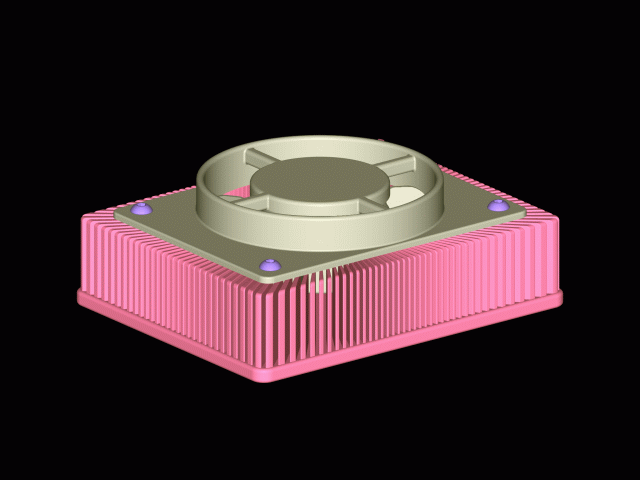
Perspective view of a cast aluminum microprocessor cooler. Developed for a leading semiconductor company, this low-cost cast aluminum heat sink measures 89mm by 64mm by 35mm (including blower), with a total thermal resistance of 0.29 °C/W. The volumetric thermal efficiency equals 0.013 W/°C/cc. Total weight 195 grams.
ConvolutedFinHeatSinks
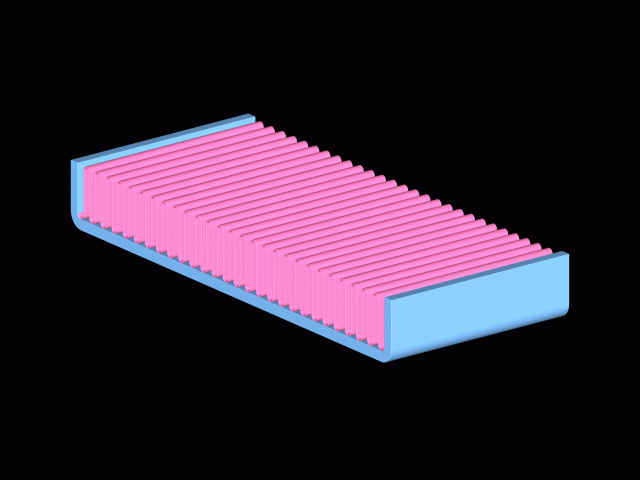
Perspective view of a copper convoluted fin heat sink. These copper convoluted fins are brazed onto a solid copper heat spreader. Developed for a tablet computer company, this low-cost copper heat sink measures 35mm by 15mm by 5mm, with a total thermal resistance of 1.83 °C/W. This heat sink was optimized for 1.25 CFM at 0.35 inches of water. The volumetric thermal efficiency equals 0.208 W/°C/cc. Total weight 7.5 grams.
FoldedFinHeatSinks
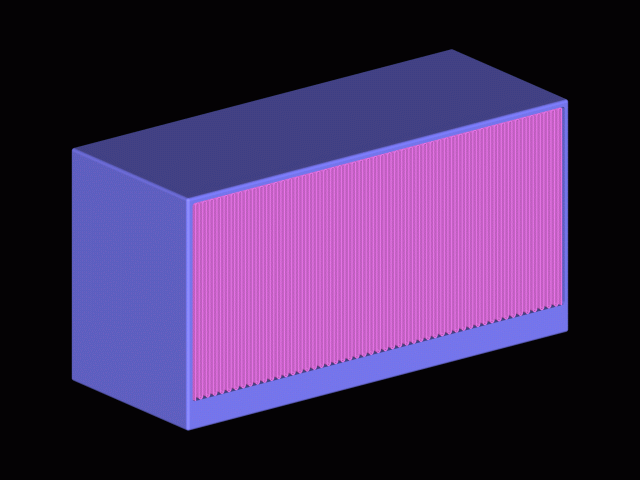
Perspective view of a copper folded fin heat sink. These copper folded fins are brazed to a solid copper heat spreader base. Developed for semiconductor cooling, this low-cost copper heat sink measures 78mm by 31mm by 40mm, with a total thermal resistance of 0.209 °C/W. This heat sink was optimized for 9.0 CFM at 0.31 inches of water. The volumetric thermal efficiency equals 0.049 W/°C/cc. Total weight 345.5 grams.
BrazedAluminumHeatSinks
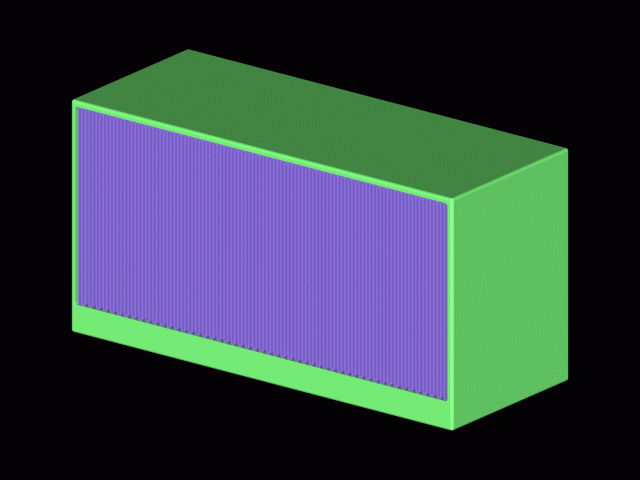
Perspective view of a brazed aluminum folded fin heat sink. These aluminum folded fins are brazed to an aluminum heat spreader base. Developed for high power semiconductor cooling, this low-cost aluminum heat sink measures 78mm by 31mm by 40mm, with a total thermal resistance of 0.292 °C/W. This heat sink was optimized for 8.7 CFM at 0.32 inches of water. The volumetric thermal efficiency equals 0.035 W/°C/cc. Total weight 104.4 grams.
BrazedCopperHeatSinks
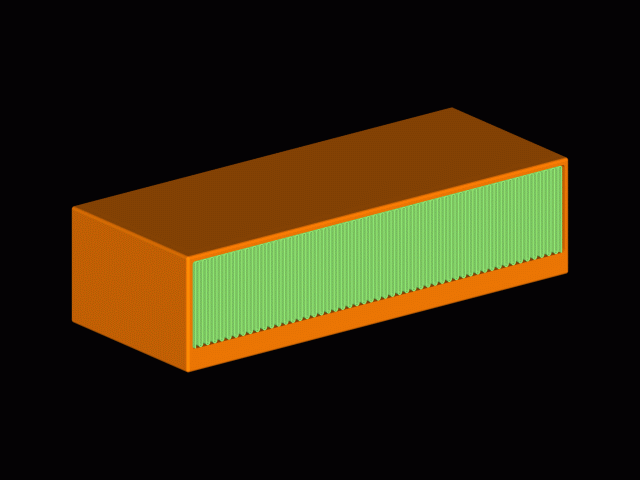
Perspective view of a brazed copper folded fin heat sink. These copper folded fins are brazed to a solid copper heat spreader base. Developed for a microprocessor cooling server application, this low-profile low-cost copper heat sink measures 78mm by 31mm by 20mm high, with a total thermal resistance of 0.275 °C/W. This heat sink was optimized for 7.7 CFM at 0.37 inches of water. The volumetric thermal efficiency is 0.069 W/°C/cc. Total weight 203.9 grams.
RadialFinHeatSinks
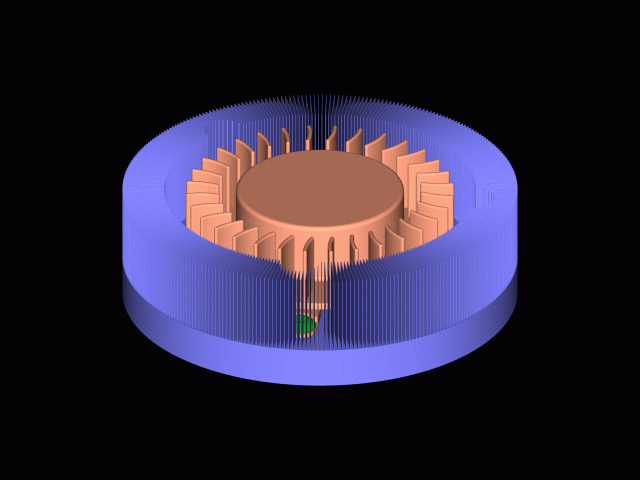
Perspective view of a fan cooled copper radial fin heat sink. These copper fins are brazed to a solid copper heat spreader base. Developed for a microprocessor server application, this very-low-profile low-cost copper heat sink measures 47mm in diameter by 14mm high, with a total thermal resistance of 0.556 °C/W. This heat sink was optimized for a 32mm radial blower. The volumetric thermal efficiency is 0.023 W/°C/cc. Total weight 88.7 grams, including blower.
RadialCopperHeatSinks
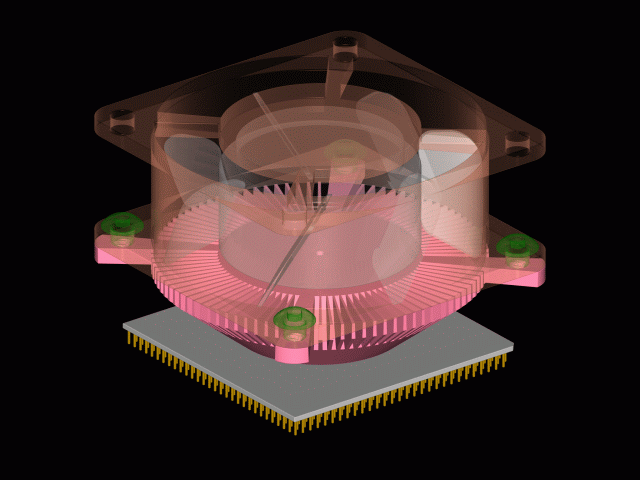
Perspective view of a copper radial fin heat sink. These copper fins are machined from a solid copper heat spreader base. Developed for a microprocessor computer application, this low-profile low-cost copper heat sink measures 60mm in diameter by 40mm high (including fan), with a total thermal resistance of 0.610 °C/W. This heat sink was optimized for a 60mm by 25mm tubaxial fan. The volumetric thermal efficiency is 0.062 W/°C/cc. Total weight 302.0 grams, including fan.
RadialCopperHeatSinks
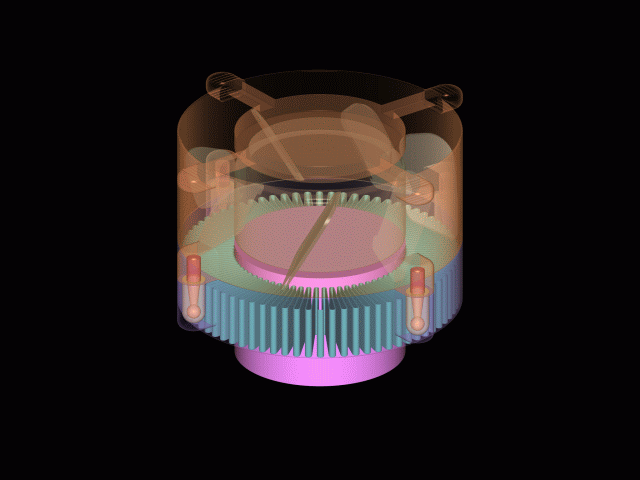
Perspective view of a fan cooled radial copper microprocessor cooler, using a cylindrical heat pipe heat spreader and radial convoluted fins. This cooler measures 60mm in diameter by 51mm high (including fan), and has a total thermal resistance is 0.15 °C/W. The volumetric thermal efficiency is 0.046 W/°C/cc. Total weight 170 grams (including fan).
HEATSPREADERS
Novel Concepts has developed and patented a wide variety of active heat spreader technologies. Active heat spreaders, also known as vapor chambers, or flat heat pipes, may have effective thermal conductivities as high as 20,000 W/m*K for short heat transport distances, and easily 100,000 W/m*K as heat transport distances approaching 1.0 meter.
Novel Concepts can solve most heat spreader applications with improved heat sinks.
The advantages of active heat spreaders are their low thermal transport resistance, low cost, small size, and lightweight. These active heat spreaders may also be developed into almost any geometry, from thin flat planar sheets, to complex 3D shapes.
Active heat spreaders may exhibit variable thermal conductivity, having either a positive temperature coefficient (PTC), or a negative temperature coefficient (NTC). The variable thermal conductivity of these materials may range from 1 to 1,000's of W/m*K and may have an order of magnitude (10X) change in thermal conductivity with as little as 20°C change.
These variable thermal conductivity materials may be controlled by numerous independent variables including temperature, power, and force.
WorldThinnestCapillaryHeatSpreaders
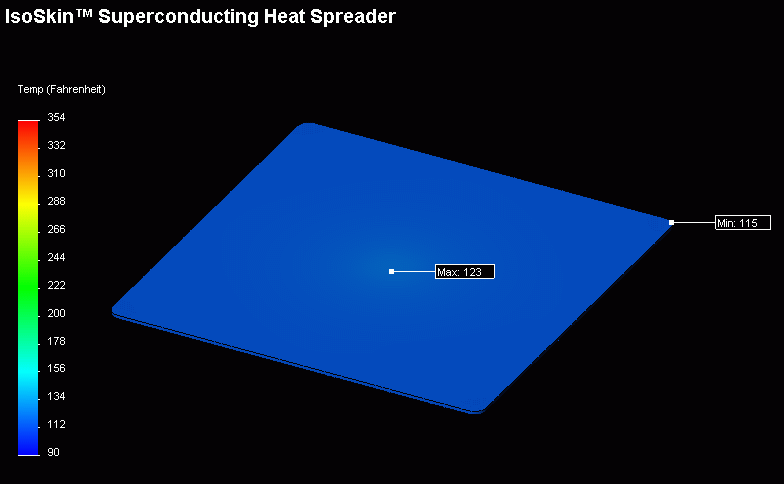
Developed and patented by Novel Concepts, this superconducting planar capillary heat spreader thermal empirical analysis illustrates the isothermal performance of a 162mm by 162mm by 1.5mm design, with a 4 square centimeter 100 watt heat source centered on one side, and a convection coefficient of 381 watts per square meter Kelvin on the other side. Note that the maximum temperature (123°F) to minimum temperature (115°F) differential is only 8°F. This same sized heat spreader from copper has a maximum temperature (270°F) to minimum temperature (96°F) differential of 174°F, and even worse, aluminum has a maximum temperature (354°F) to minimum temperature (90°F) differential of 264°F.
US Patents 6,158,502 and 6,167,948.
SolidCopperHeatSpreaders
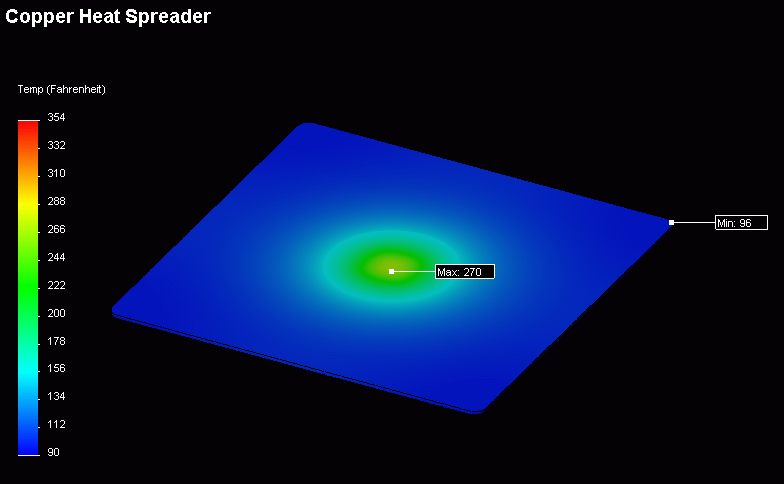
This solid copper heat spreader thermal empirical analysis illustrates the thermal performance of a 162mm by 162mm by 1.5mm sized unit, with a 4 square centimeter 100 watt heat source centered on one side, and a convection coefficient of 381 watts per square meter Kelvin on the other side. Note that the maximum temperature (270°F) to minimum temperature (96°F) differential is 174°F. This same sized heat spreader from aluminum has a maximum temperature (354°F) to minimum temperature (90°F) differential of 264°F. Amazingly, a superconducting planar capillary heat spreader developed by Novel Concepts has a maximum temperature (123°F) to minimum temperature (115°F) differential of only 8°F.
SolidAluminumHeatSpreaders

This solid aluminum heat spreader thermal empirical analysis illustrates the thermal performance of a 162mm by 162mm by 1.5mm sized unit, with a 4 square centimeter 100 watt heat source centered on one side, and a convection coefficient of 381 watts per square meter Kelvin on the other side. Note that the maximum temperature (354°F) to minimum temperature (90°F) differential is 264°F. This same sized heat spreader from copper has a maximum temperature (270°F) to minimum temperature (96°F) differential of 174°F. Incredibly, a superconducting planar capillary heat spreader developed by Novel Concepts has a maximum temperature (123°F) to minimum temperature (115°F) differential of only 8°F.
ThinFlatHeatSpreaders
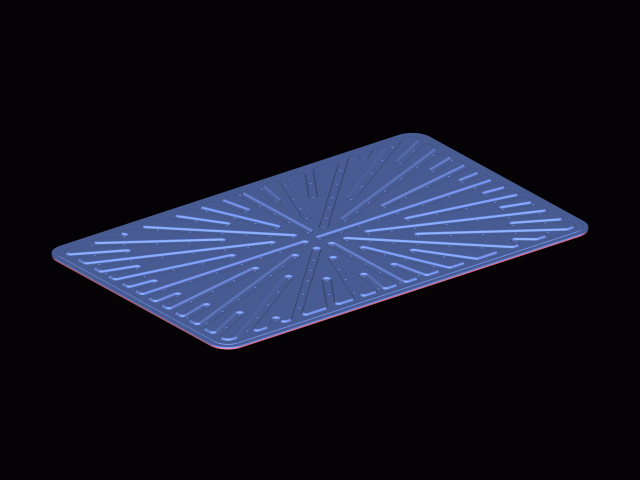
This credit card sized 500 micron thick flat heat spreader was developed to cool heat sources such as microprocessors and related power semiconductor chips. This two-piece copper water heat spreader may be used in portable electronics such as notebook computers, tablets, cellular phones, PCMCIA cards, hard drives, or handheld electronics, eliminating the need for heat sinks and fans. These planar capillary heat spreaders can be fabricated as thin as 500 microns (thinner than a credit card), using any metal. Utilizing heat pipe physics, these planar capillary heat spreaders can achieve thermal conductivities of 20,000 W/m*K (10 times greater than diamond) (50 times greater than copper).
ThinFlatHeatSpreaders
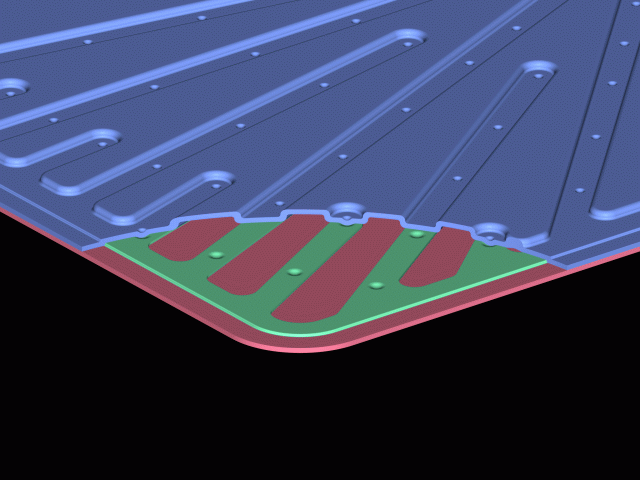
This perspective cut-away view of a 500 micron thick flat heat pipe shows the 1.5 mm wide by 125 microns thick, continuous liquid radial planar capillary (aqua), which is formed between the evaporator sidewall (red ) and the condenser sidewall (blue). Also note that due to capillary physics, the planar capillary is only formed where the distance between the sidewalls is small. In other words, where the distance between sidewalls is large (the embossed region), surface tensions cannot support the planar capillary. These larger non-capillary regions are for vapor transport.
ThinFlatHeatSpreaders

This perspective cut-away view of the 500 micron thick planar capillary active heat spreader shows the 1.5 mm wide by 125 microns thick, continuous liquid radial planar capillary (aqua), which is formed between the evaporator sidewall (red) and the condenser sidewall (blue). Also note that due to capillary physics, the planar capillary is only formed where the distance between the sidewalls is small. In other words, where the distance between sidewalls is large (the embossed region), surface tensions cannot support the planar capillary. These larger non-capillary regions are for vapor transport.
ThinFlexibleHeatSpreaders
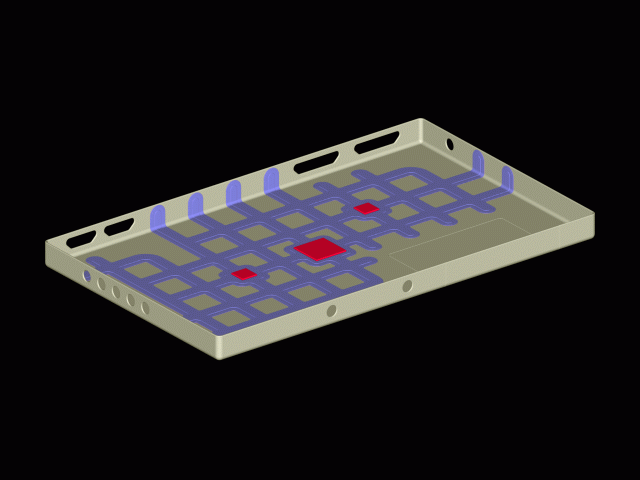
Perspective view of a 500 micron thick flexible aluminum ammonia heat spreader (blue) formed to the inside contours of a notebook computer shell. This thin flexible heat spreader device was developed to uniformly distribute heat from multiple heat sources (red) to the plastic computer shell, eliminating the need for additional heat sinks and fans.
FlatActiveHeatSpreaders
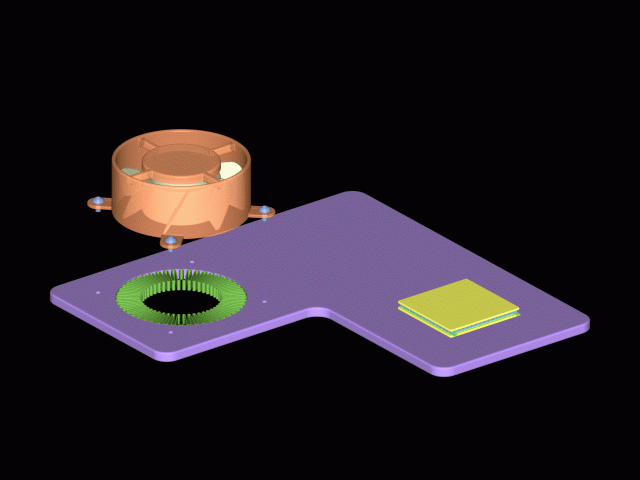
Perspective view of a low profile forced convection cooled heat sink, using a flat planar active heat pipe heat spreader base, with inlaid radial convoluted cooling fins. Developed for an electronics company, this low profile heat sink (5mm without fan) has a total thermal resistance of 0.36 °C/W. The volumetric thermal efficiency is 0.026 W/°C/cc. Total weight 397 grams (including fan).
NotebookCoolerHeatSpreaders
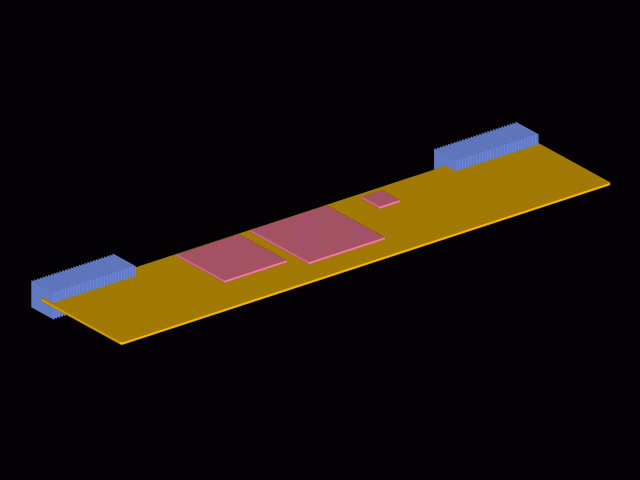
Perspective view of a thin flat aluminum ammonia heat pipe heat spreader (orange) for a notebook computer, with aluminum cooling fins (blue), and multiple heat sources (red). Only 1mm thick, this thin planar heat spreader replaces multiple 5mm diameter heat pipes, while substantially improving thermal performance.
3DAnnularHeatSpreaders
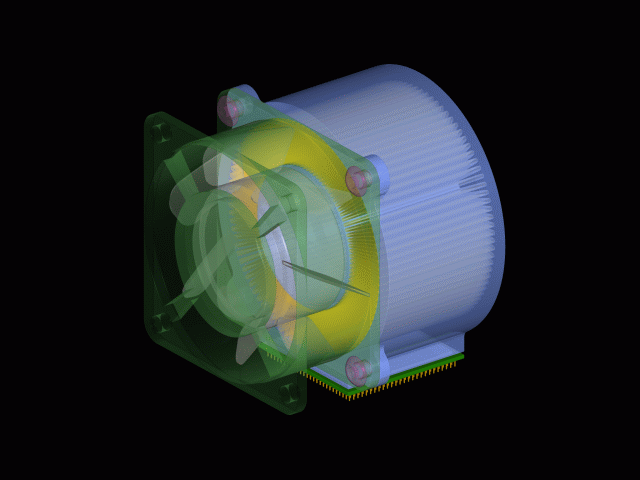
Perspective view of a 3D annular active copper heat spreader developed for a microprocessor cooling application. This annular heat pipe heat spreader provides a very low thermal resistance from the microprocessor to a set of radial convoluted fins. With a total case-to-ambient thermal resistance of 0.195 °C/W. The convoluted fin geometries are optimized around a 60mm by 25mm tubaxial fan. The volumetric thermal efficiency of this fan cooled heat sink with its integral active heat spreader is 0.017 W/°C/cc. Total weight 305.6 grams, including blower.
MultiplePlanarCapillaryHeatSpreaders
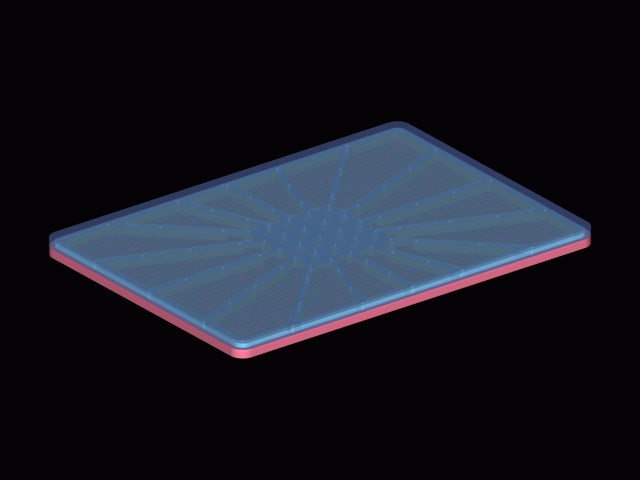
Perspective view of a copper water heat pipe heat spreader, having multiple interconnected planar capillaries, developed as a microprocessor heat sink base (fins to be added). This thin flat heat spreader provides a very low thermal resistance between the microprocessor and the cooling fins. With an effective thermal conductivity greater than solid diamond, this IsoSkin heat spreader solves the constriction resistance problem inherent with solid metals. Total weight 139.2 grams.
PELTIERCOOLERS
Novel Concepts, has been designing custom Peltier (solid state thermoelectric) modules and Peltier coolers since 1982. These Peltier coolers (thermoelectric heat pumps) have heat cooling capacities ranging from a few watts to thousands of watts. An example of the broad variety of Peltier coolers we have developed include:
low stress heat sinks for large Peltier cooler arrays
notebook, desktop, and handheld microprocessor Peltier coolers
wearable thermal Peltier cooler signaling devices
programmable Peltier cooler laser chillers for semiconductor wafer fabrication
Peltier cooled computer enclosures for the Alaska pipeline
Using proprietary software developed by Novel Concepts, all Peltier cooler thermal and electrical parameters can by independently optimized.
We routinely develop forced air convection cooled Peltier coolers with volumetric efficiencies as high as 0.50 W/cc.
Since Peltier cooler thermal performance, efficiency, and volumetric density, are directly related to its heat sink performance, and given that Novel Concepts designs and develops the highest performance heat sinks possible, Novel Concepts’ Peltier cooler designs are unmatched by any measure.
PeltierCoolersModuleDesign
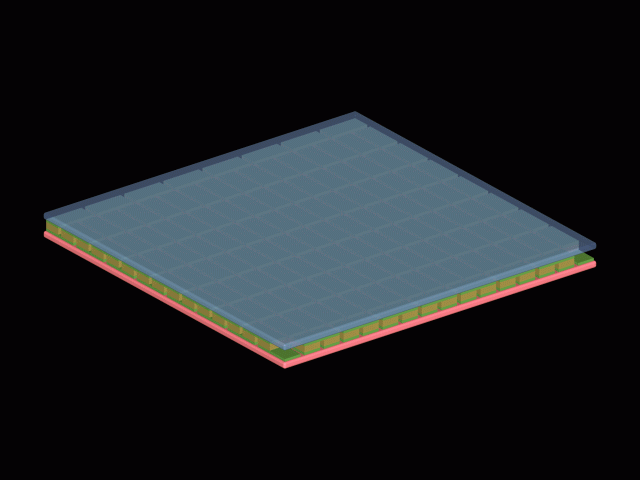
Perspective view of a Peltier (thermoelectric) cooling module, designed and developed by Novel Concepts. This Peltier module measures 40mm by 40mm by 2.8mm, with a maximum heat pump capacity of 260 watts (16.3 W/cm^2), and a maximum temperature differential of 68°C (zero load), under the following conditions: 16.0 volts, 26.6 amps, and a hot side temperature of 50°C.
PeltierCoolersModuleDesign
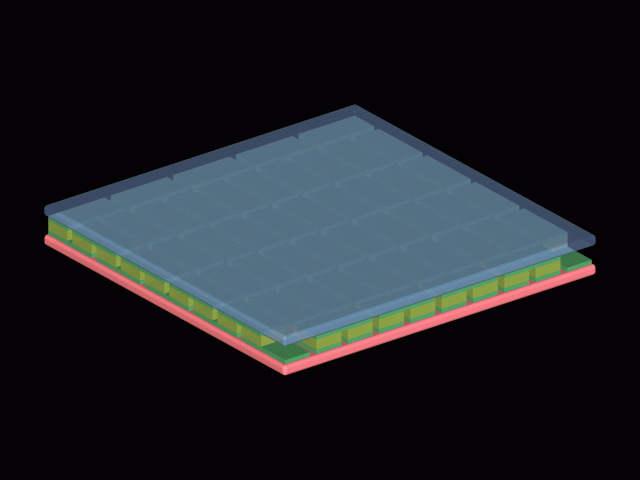
Perspective view of a custom Peltier (thermoelectric) cooling module, designed and developed by Novel Concepts. This Peltier module measures 25mm by 25mm by 2.8mm, with a maximum heat pump capacity of 102 watts (16.3 W/cm^2), and a maximum temperature differential of 68°C (zero load), under the following conditions: 6.3 volts, 26.6 amps, and a hot side temperature of 50°C.
PeltierCoolersModuleDesign
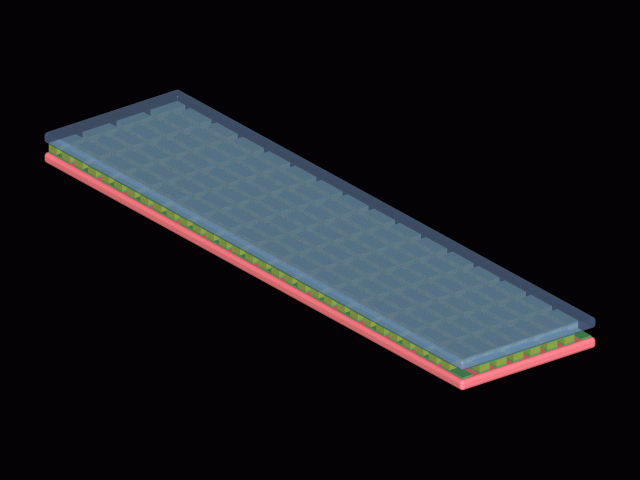
10mm PELTIER MODULE
Perspective view of a custom Peltier (thermoelectric) cooling module, designed and developed by Novel Concepts. This Peltier module measures 10mm by 38mm by 2.0mm, with a maximum heat pump capacity of 62 watts (16.3 W/cm^2), and a maximum temperature differential of 68°C (zero load), under the following conditions: 16.0 volts, 6.6 amps, and a hot side temperature of 50°C.
LiquidCooledPeltierCoolers
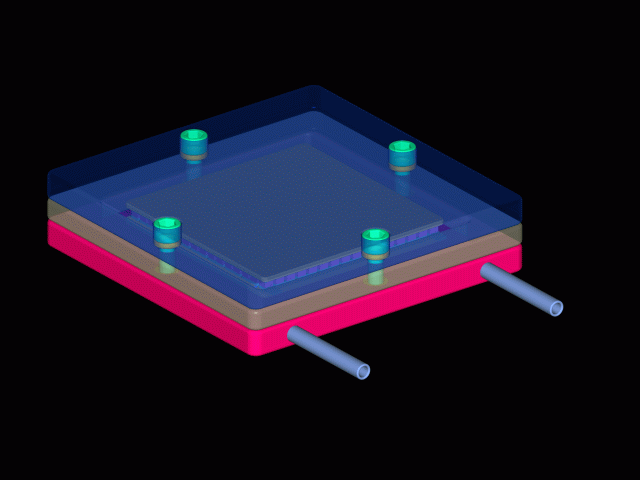
Perspective view of a liquid cooled Peltier (thermoelectric) cooler. This Peltier cooler measures 60mm by 60mm by 14mm high, and has a maximum heat pump capacity of 100 watts (2.0 W/cm^2), with a maximum temperature differential of 63°C, under the following conditions: 12.0 volts, 11.1 amps, and a hot side liquid input temperature of 50°C. This Peltier heat pump assembly uses a liquid cooled copper heat sink, which has a thermal resistance of 0.027 °C/W, with a flow rate of 0.5 liters per minute, and a pressure drop of 23.78 kPa (3.45 psi). Total weight 281 grams.
LowProfilePeltierCoolers
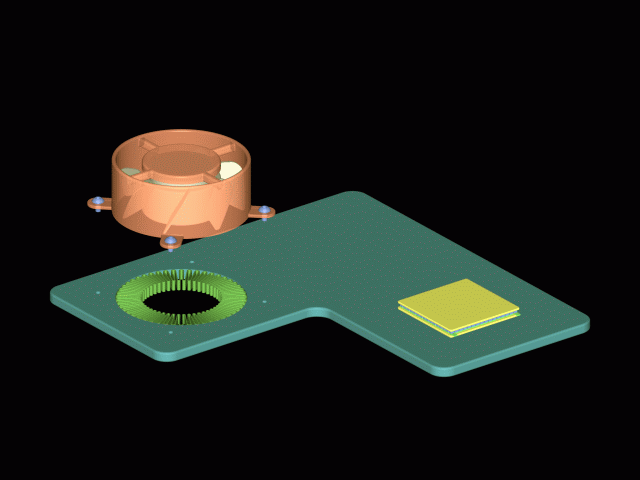
Perspective view of a low profile Peltier cooler, using an active heat pipe heat spreader base, with inlaid radial convoluted cooling fins. Developed for an electronics company, this Peltier cooler has a maximum heat pump capacity of 26 watts, with a maximum temperature differential of 45°C, under the following conditions: 12.0 volts, 4.9 amps, with an ambient temperature of 50°C. Total weight 397 grams (including fan).
AirCooledPeltierCoolers
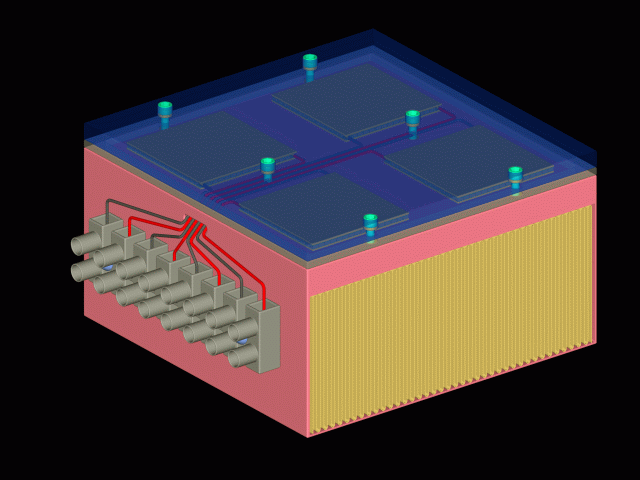
Perspective view of an air cooled Peltier (thermoelectric) cooler. This Peltier cooler measures 120mm by 120mm by 70mm high, and has a maximum heat pump capacity of 345 watts (0.34 W/cm^2), with a maximum temperature differential of 42°C, under the following conditions: 38.0 volts, 15.6 amps, and an ambient temperature of 50°C. This Peltier heat pump assembly uses a forced convection cooled copper heat sink, which has a thermal resistance of 0.034 °C/W. This heat sink was optimized for 86.3 CFM at 0.53 inches of water. Total system weight 3.5 kilograms.
UNIQUEDESIGNS
Novel Concepts has uniquely solved some of the industry's most difficult thermal challenges. With a special focus on computer design variable optimization, Novel Concepts can quickly explore a large solution space, allowing for greater design flexibility, while improving the chances for finding those "unique patentable solutions" necessary for today's competitive environment, including the following examples:
world's thinnest integrated fan heat sinks (patented)
world's thinnest active heat spreader (patented)
world's most thermally conductive plastic (patented)
world's thinnest forced convection heat sinks (patent pending)
very high efficiency (9%) solar updraft tower power plant SUTPP
lightweight air and liquid heat sinks, for military robotics
Peltier coolers (solid state thermoelectric coolers)
microfluidic cooling plates (microchannel heat sinks)
variable thermal conductivity materials (both PTC and NTC)
wearable thermal signaling devices
high efficiency (>90%) concentrated solar power receivers
lightweight compact heat exchangers for aerospace and avionics
cooling systems for unmanned vehicles (UAV, UGA, USV, UUV)
solid state temperature sensors for data acquisition
thin film and thick film heaters, on ceramic and glass
all-polyimide low thermal time constant heaters
transparent sapphire heaters
transient phase change heat sinks
SolarUpdraftTowerPowerPlant
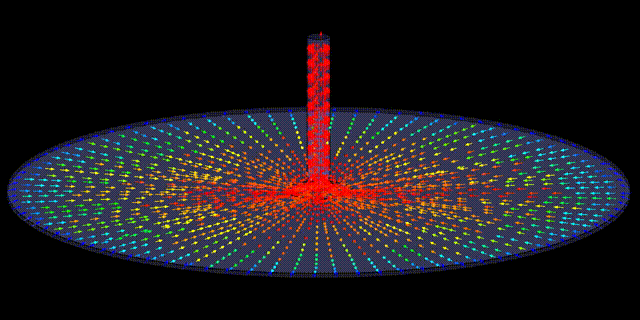
A Solar Updraft Tower Power Plant (SUTPP) generates electricity from low temperature solar heat.
Solar radiation heats the air beneath a canopy structure (collector), which surrounds the base of a chimney tower. The resulting convection causes a hot air updraft in the tower by thermal buoyancy. This updraft drives wind turbines near the base of the tower, to produce electricity.
Using high-resolution Computational Fluid Dynamics (CFD) analysis, integrated with shape optimization algorithms, Novel Concepts has developed a nine percent (9%) net efficiency SUTPP design.
The 9% net efficiency SUTPP design depicted above, has an 850 m diameter canopy, and a 200 m high tower. With a solar power input of 555 MW, and a 45% efficient wind turbine generator, this SUTPP design generates 50 MW of electricity (325 MW per day).
With the solar chimney depicted above, over 300 million cubic meters of air per day flows through the chimney. This enormous volume of air flow has many additional uses including, low level air pollution removal, and direct air capture (DAC) carbon (CO2) capture systems.
SolidStateTemperatureSensors
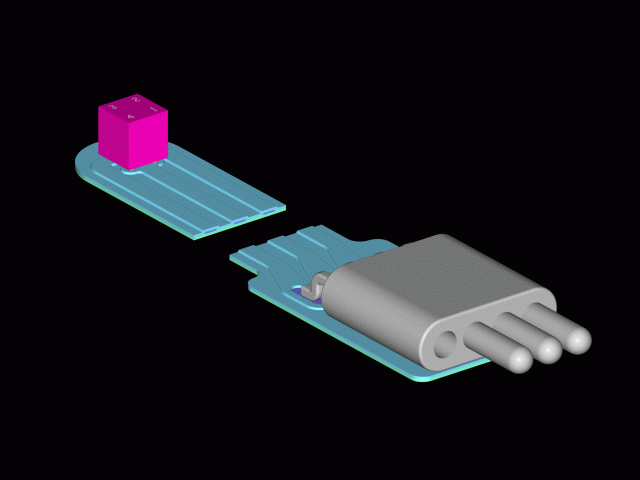
Perspective view of a solid state temperature sensor with micro-interconnect, designed and developed by Novel Concepts. This solid state micro thermal sensor is designed to be directly powered, controlled, and interfaced to standard data acquisition hardware. This solid state micro thermal sensor measures less than 1mm cubed, and is surface mounted onto the end of a 2mm wide flexible circuit, which terminates with a micro-connector. Its operating temperature range is -50°C to 125°C, with a full scale accuracy of +/- 0.25°C.
The supply voltage is from 1.9V to 5.4V, well within the output of standard data acquisition hardware. The full scale output voltage is an astounding 0.3V to 2.5V, which is immune to micro-voltage noise that plagues thermocouples, and is perfect for direct 0-5V analog input. The output voltage gain is 11.8 mV/°C, which is far greater than thermistors and RTDs. The thermal time constant is less than 3 milliseconds.
All-PolyimideFlexibleHeaters

Perspective view of an annular all-polyimide flexible heater. This all-polymer heater measures 53mm O.D. by 40mm I.D. by 0.16mm, with a 75mm long interconnect, and weighs 1.8 grams. The heated circuit region is 6.14 square centimeters, and has an electrical resistance of 38 ohms. The maximum operating temperature is 200°C, and at 25°C this all-polymer heater has a maximum power density of 30 W/cm^2, or 175 watts. The thermal time constant is 33 milliseconds. Available in various polymers such as Teflon, Polyimide, Liquid Crystal Polymer, Nylon, PEEK, and Polyphthalamide.
HighDensitySapphireHeaters
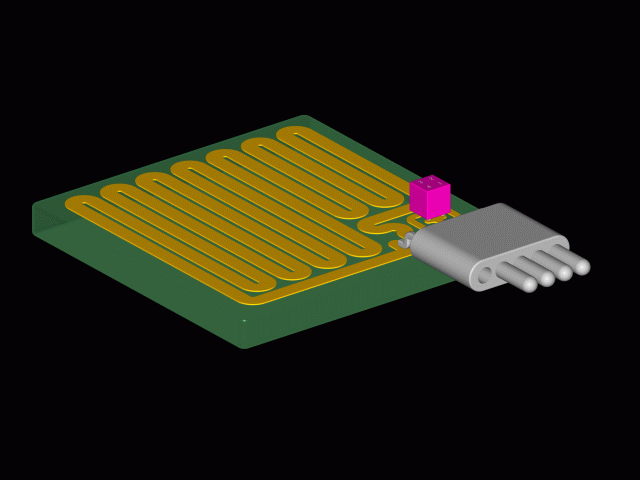
Perspective view of a high power density sapphire heater with gold circuit. This sapphire/gold heater measures 10mm by 10mm by 1.0mm, weighs less than 0.5 grams, and its surface mounted solid state temperature sensor and micro-connector allow closed loop control by standard data acquisition hardware. The heated circuit region is 1.0 square centimeter, and has an electrical resistance of 12 ohms. The maximum operating temperature is 200°C, and at 25°C this sapphire/gold heater has a maximum power density of 200 W/cm^2, or 200 watts. The thermal time constant is 67 milliseconds.
HighPowerBerylliaHeaters
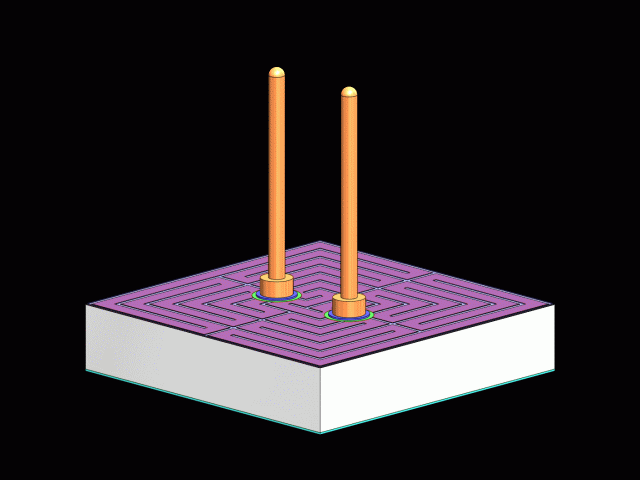
Perspective view of a high power density beryllia heater with platinum circuit, and gold plated electrical contacts. This beryllia/platinum heater measures 10mm by 10mm by 2mm, weighs less than 0.7 grams, and has an intrinsic RTD temperature sensor, facilitating closed loop control by standard data acquisition hardware. The bottom of this miniature heater is pre-tinned for soldering in place.
The heated circuit region is 1.0 square centimeter, and has an electrical resistance of 14 ohms. Heat flux uniformity is 98%. The maximum operating temperature is 350°C, and this beryllia/platinum heater has a power density of 500 W/cm^2, or 500 watts. The thermal time constant is 37 milliseconds.
HighPowerAluminumNitrideHeaters

Perspective view of a high power density aluminum nitride heater with platinum circuit, and gold plated electrical contacts. This aluminum nitride/platinum heater measures 7.1mm by 7.1mm by 2mm, weighs less than 0.4 grams, and has an intrinsic RTD temperature sensor, facilitating closed loop control by standard data acquisition hardware. The bottom of this miniature heater is pre-tinned for soldering in place.
The heated circuit region is 0.5 square centimeters, and has an electrical resistance of 14 ohms. Heat flux uniformity is 98%. The maximum operating temperature is 350°C, and this aluminum nitride/platinum heater has a power density of 500 W/cm^2, or 250 watts. The thermal time constant is 37 milliseconds.
HighPowerAluminaHeaters

Perspective view of a high power density alumina heater with platinum circuit, and gold plated electrical contacts. This alumina/platinum heater measures 5mm by 5mm by 2mm, weighs less than 0.2 grams, and has an intrinsic RTD temperature sensor, facilitating closed loop control by standard data acquisition hardware. The bottom of this miniature heater is pre-tinned for soldering in place.
The heated circuit region is 0.25 square centimeters, and has an electrical resistance of 14 ohms. Heat flux uniformity is 98%. The maximum operating temperature is 350°C, and this alumina/platinum heater has a power density of 500 W/cm^2, or 125 watts. The thermal time constant is 37 milliseconds.
THERMALCALCULATORS
The following thermal calculators are provided to assist you with your thermal management problems.
SlabThermalResistance
This one-dimensional steady-state heat conduction calculator provides the thermal resistance through the height axis of a solid slab, given uniform heat input and output, and having insulated sidewalls.
CylinderThermalResistance
This one-dimensional steady-state heat conduction calculator provides the thermal resistance through the height axis of a solid cylinder, given uniform heat input and output, and having insulated sidewalls.
HollowCylinderThermalResistance
This one-dimensional steady-state heat conduction calculator provides the thermal resistance through the sidewall of a hollow cylinder, given uniform heat input and output, and having insulated ends.
SlabThermalResistancewithConstriction
This two-dimensional steady-state heat conduction calculator provides the thermal resistance through the height axis of a solid slab, flat heat pipes, vapor chambers, or heat spreaders, including the thermal constriction resistance resulting from a heat source that is smaller than the slab, given uniform heat input and output, and having all other surfaces insulated.
SlabMassThermalResistance
This one-dimensional transient heat capacitance calculator provides the thermal resistance of a solid slab, given the mass thermal properties, finite heat input, and being fully insulated.
MassFlowThermalResistance
This one-dimensional steady heat capacitance calculator provides the thermal resistance of a mass flow system, given the mass thermal properties and flow rate.
SlabFinEfficiency
This one-dimensional steady-state heat conduction calculator provides the fin efficiency or effectiveness of a slab or cuboid shaped fin, given uniform cross-sectional area, uniform heat input, and insulated ends.
PinFinEfficiency
This one-dimensional steady-state heat conduction calculator provides the fin efficiency or effectiveness of a pin or cylindrical shaped fin, given uniform cross-sectional area, uniform heat input, and insulated ends.
ForcedConvectionHeatSinkResistance
This steady-state forced convection heat sink calculator provides thermal resistance and pressure drop, given uniform heat input and uniform air flow. This model is based on the fluid properties of air at 50°C, and includes entrance and exit pressure loss effects, and excludes any base conduction resistance.
PeltierCoolerThermalPerformance
This steady-state calculator provides the thermal and electrical performance of a Bismuth Teluride based solid state thermoelectric Peltier cooling system, as a function of ambient temperature, hot and cold side heat exchanger performance, thermal load, Peltier module (thermopile) geometry, and Peltier electrical parameters.